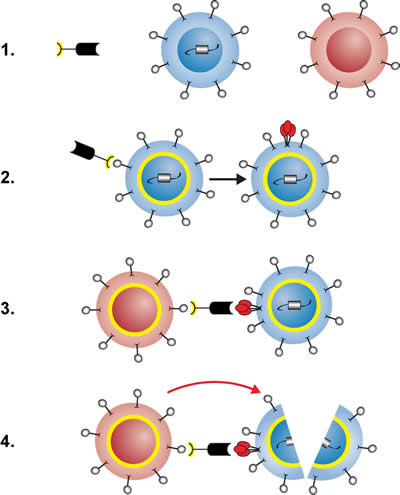HIV cure research: NIH scientists create 2-headed protein to deplete HIV reservoir

Caption
This is an illustration of how the engineered protein facilitates destruction of latently HIV-infected immune cells. 1) Protein and cells, from left to right: engineered protein with yellow-and-black CD3-binding end and thick black HIV-binding end; latently HIV-infected helper T cell (blue); inactivated killer T cell (red). 2) Protein binds to CD3 receptor on helper T cell, activating it so the helper T cell starts making HIV and displaying pieces of virus (red) on its surface. 3) Protein binds to HIV fragment on helper T cell and CD3 receptor on killer T cell, activating the killer T cell and bringing the two cells close together. 4) Activated killer T cell destroys HIV-infected helper T cell. Credit: NIAID
NIH/National Institute of Allergy and Infectious Diseases
20-Oct-2015 - Scientists at the National Institutes of Health (NIH) have created a protein that awakens resting immune cells infected with HIV and facilitates their destruction in laboratory studies. The protein potentially could contribute to a cure for HIV infection by helping deplete the reservoir of long-lived, latently HIV-infected cells that can start making the virus when a person stops taking anti-HIV drugs. Further studies in animals and people are needed to determine the viability of this approach.
The researchers found that the protein, called VRC07-aCD3, triggered the activation and killing of latently HIV-infected helper T cells when the cells were taken from patients on antiretroviral therapy and then incubated in the lab with the patients' own killer T cells. In addition, the scientists found a monkey-adapted version of the protein to be safe and well-tolerated when given to monkeys infected with a simian form of HIV and receiving antiretroviral therapy. The researchers are now studying the effectiveness of monkey-adapted VRC07-aCD3 in the animals.
The engineered protein has two ends: one activates T cells by binding to a surface molecule called the CD3 receptor, and the other--based on an antibody called VRC07--powerfully binds to more than 90 percent of HIV strains. VRC07-aCD3 facilitates the killing of latently HIV-infected cells in three steps. First, the CD3-binding end attaches to a resting, HIV-infected helper T cell, activating the cell so it starts making HIV and displaying pieces of virus on its surface. Next, the HIV-binding end of the protein latches onto those pieces of virus while the CD3-binding end attaches to a killer T cell, activating it and bringing it close to the helper T cell. Finally, the activated killer T cell destroys the HIV-infected helper T cell.
A team of scientists at the Vaccine Research Center (VRC) of the National Institute of Allergy and Infectious Diseases, part of NIH, created VRC07-aCD3 under the leadership of VRC Director John R. Mascola, M.D.; former VRC Director Gary J. Nabel, M.D., Ph.D.; and Richard A. Koup, M.D., VRC deputy director and chief of its immunology laboratory.
###
ARTICLE:
A Pegu et al . Activation and lysis of human CD4 cells latently infected with HIV-1. Nature Communications DOI: 10.1038/ncomms9447 (2015).
WHO:
NIAID Director Anthony S. Fauci, M.D., and VRC Director John R. Mascola, M.D., are available for interviews.
CONTACT:
To schedule interviews, please contact Laura S. Leifman, (301) 402-1663, laura.sivitz@nih.gov.
NIAID conducts and supports research--at NIH, throughout the United States, and worldwide--to study the causes of infectious and immune-mediated diseases, and to develop better means of preventing, diagnosing and treating these illnesses. News releases, fact sheets and other NIAID-related materials are available on the NIAID website.
About the National Institutes of Health (NIH):
NIH, the nation's medical research agency, includes 27 Institutes and Centers and is a component of the U.S. Department of Health and Human Services. NIH is the primary federal agency conducting and supporting basic, clinical, and translational medical research, and is investigating the causes, treatments, and cures for both common and rare diseases. For more information about NIH and its programs, visit http://www.nih.gov.
Source: http://www.eurekalert.org/pub_releases/2015-10/nioa-hcr102015.php
For more HIV and AIDS News visit...
Positively Positive - Living with HIV/AIDS:
HIV/AIDS News |